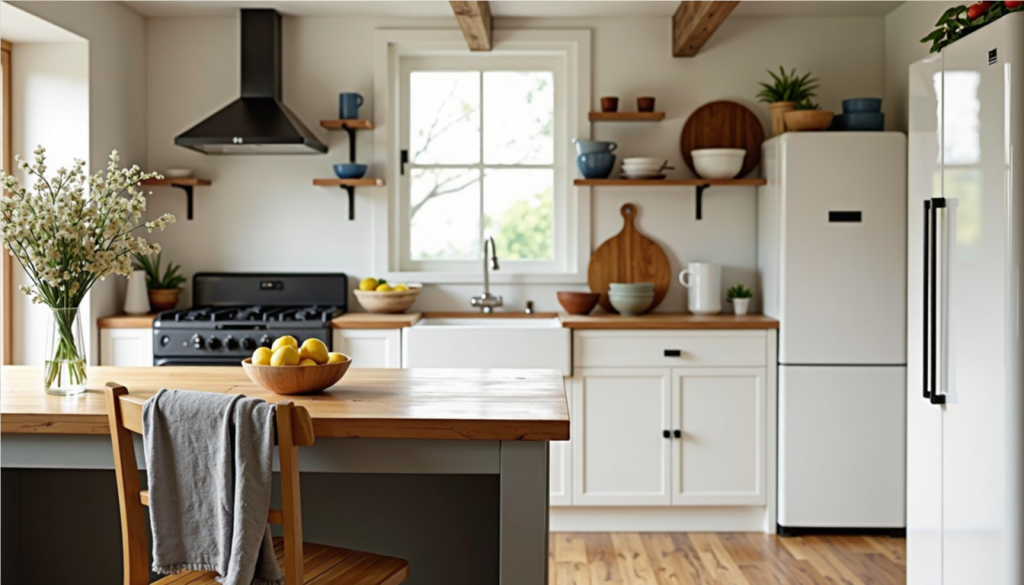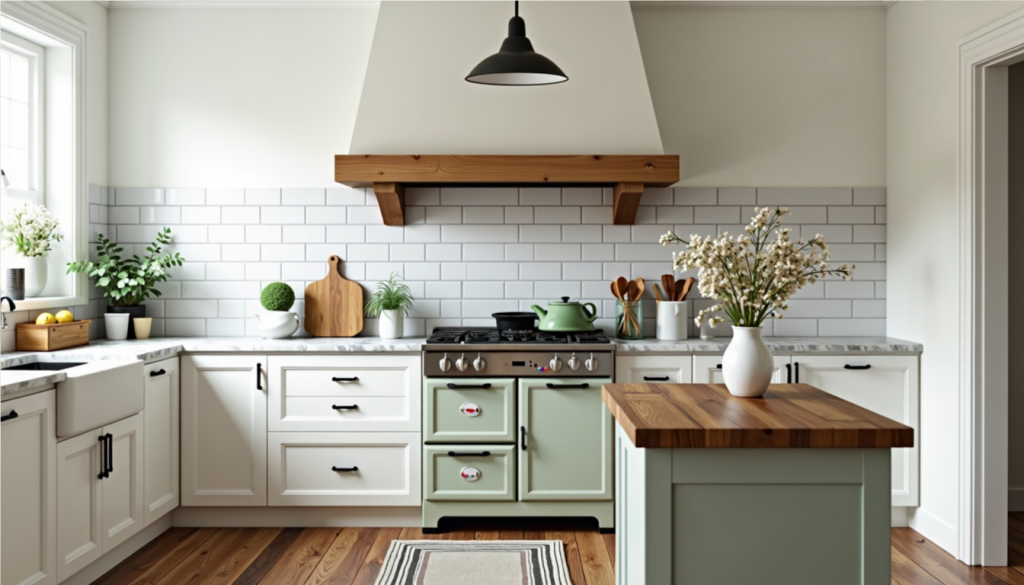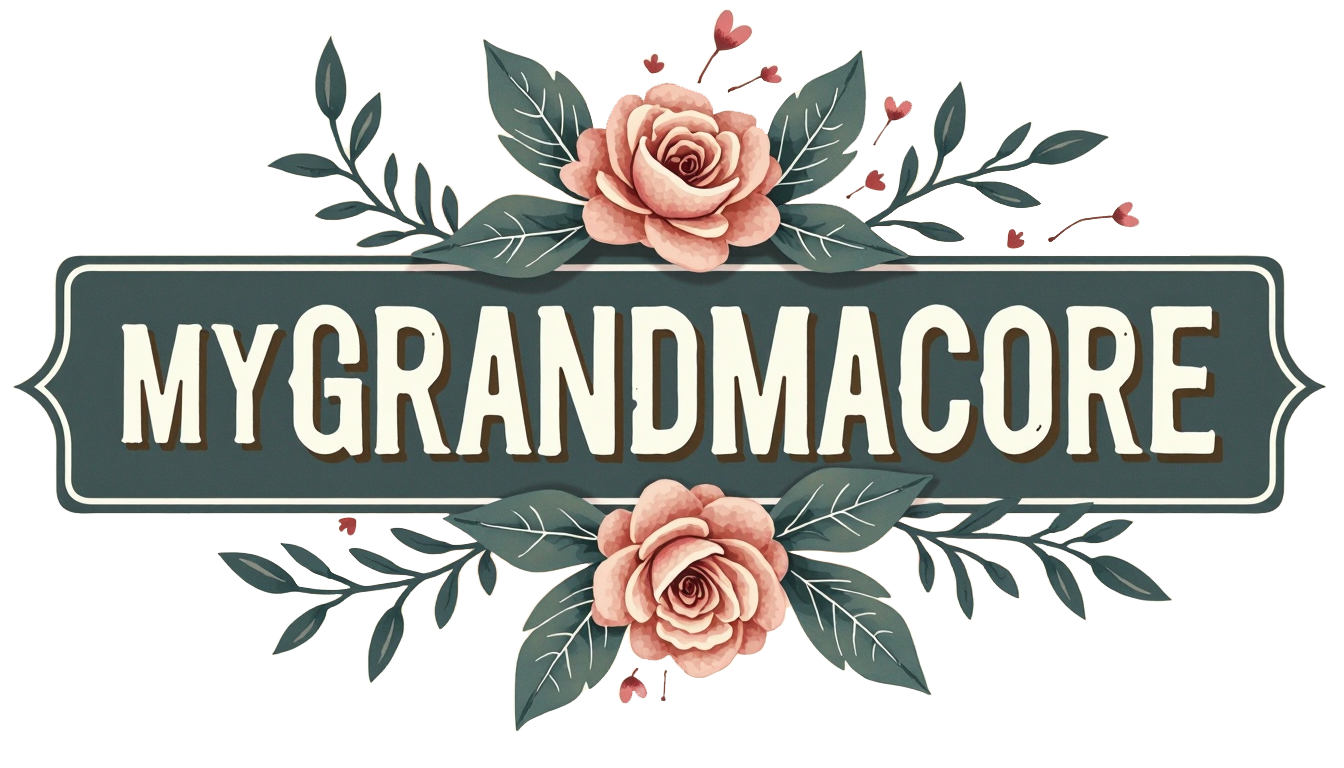Key Takeaways
- White and warm neutrals are essential for creating a cozy farmhouse kitchen.
- Earth tones like browns and greens add a natural, rustic feel to your space.
- Blue and green hues can freshen up the look while maintaining the farmhouse charm.
- Pairing colors with natural elements like wood and stone enhances the farmhouse aesthetic.
- Balance light and dark hues to maintain a harmonious and inviting atmosphere.
Farmhouse Kitchen Color Palettes: Best Colors & Design Tips Guide
Creating a farmhouse-style kitchen is really about crafting a room that oozes comfort, welcome, and a touch of rustic appeal. You’d be surprised just how essential the right mix of colors is to stir up this vibe. Getting a good grasp on the farmhouse look and picking out the perfect hues can turn your kitchen into a snug retreat that pulls in both family and friends.
Setting the Tone with Farmhouse Colors
Understanding Farmhouse Aesthetics as Part of the GrandmaCore Vibe
The essence of farmhouse style lies in its plainness and practicality, taking a leaf out of rural design and way of life. It beautifully marries the allure of yesteryears with contemporary ease. The most striking components are visible joists, retro light fittings, and organic materials such as timber and rock. Yet, the real charm emerges when you skillfully pick hues that enhance these characteristics.
Importance of Color in Farmhouse Kitchens
Color isn’t just about what you see – it’s the vibe, the aura it gives off in a room. Take a farmhouse kitchen, for example. The hues you pick can either dial up the country charm or dial it way down. So, what you want to do is to pick shades that match the farmhouse vibe and, at the same time, show off a bit of your own flair. Get this balance right, and your kitchen will be a warm, inviting place, with a crisp, clean finish.
Top Color Palettes for a Cozy Farmhouse Kitchen
Classic White and Warm Neutrals
In farmhouse style kitchens, white reigns supreme. It’s the magic trick that pulls everything together—it’s fresh, clean, and timeless. When you pair it up with warm, cozy neutrals like beige and cream, you’ve got a winning combo. These shades bring a calming aura to the backdrop, letting other design elements take center stage. They’re a safe bet for cabinets, walls, and trim, giving you a versatile base that’s primed and ready for any decor or accessory updates.
Now, let’s talk about these warm neutrals. They’re like the secret sauce to a stark white kitchen, layering on some depth and, yes, a bit of warmth. In a kitchen that gets a lot of natural light, these colors work their magic, boosting the brightness while keeping things nice and cozy.
So here’s a quick rundown:
White: A knockout choice for walls and cabinets.
Beige: Your go-to for a warm hue on countertops and backsplashes.
Cream: The cherry on top, perfect for trim and accents.

Earth Tones and Natural Shades
Can’t get enough of the great outdoors? Well, you can bring it right into your kitchen with earthy tones. Think about it – the rich browns, the calming greens, and the cozy terracotta hues. Perfect for that farmhouse kitchen look you’ve been dreaming of. Walls, floors, cabinets, even appliances – these tones are versatile and can work their magic anywhere.
And don’t just stop at colors. Think textures too! Natural materials like wood and stone add to that farmhouse feel. Picture this – a kitchen island painted in a deep, soothing green paired with wooden countertops. It’s a match made in heaven, a perfect blend of color and texture.
Let’s break it down:
– Brown: Imagine wooden beams and floors. Rich, dark, and oh-so-rustic.
– Green: Why not give your accent walls or kitchen island a touch of this calming color?
– Terracotta: This warm hue can add a dash of coziness to your tiles and backsplashes.
So, if you’re planning to spruce up your kitchen, don’t forget to check out some farmhouse color ideas. Trust me, you won’t regret it.
Blue and Green Hues for a Fresh Touch
Sprucing up the classic farmhouse color scheme with shades of blue and green can breathe new life into the design, all while keeping the rustic appeal intact. You can’t go wrong with gentle blues and understated greens—they whip up a peaceful and soothing atmosphere, which makes them a great choice for your kitchen’s walls or cabinets.
Incorporating Accents and Bold Colors
While simplicity is often the name of the game in farmhouse kitchens, a splash of vibrant color can really rev up the personality of the space. There’s no need to go all out; sometimes, it’s the little things that leave the most lasting impression. Try introducing bursts of color with nifty accessories like area rugs, drapes, or even smaller appliances. These pieces can deliver a vibrant punch without overpowering the room.
For the more daring among us, why not take a paintbrush to a single wall or kitchen island? A deep-sea blue or a spicy mustard yellow can serve as a real showstopper, pulling the gaze and adding a sense of depth to the space. The trick is to harmonize these audacious splashes with the gentle, neutral shades that are the hallmark of the farmhouse aesthetic.
Bear in mind, the aim here is to amplify the charm of the existing design, not to overshadow it. So, opt for shades that gel well with the overall color scheme and existing decor. That way, your kitchen will remain a unified and visually pleasing space.
Design Tips for Using Farmhouse Color Palettes
Creating a farmhouse kitchen isn’t just about picking hues, it’s about crafting a balanced space where every detail fits in perfectly. Here’s a bit of advice to guide you in making the most out of farmhouse color schemes.
Pairing Colors with Natural Elements
The charm of farmhouse design lies in its embrace of raw, natural elements such as wood, stone and metal. These materials do more than just add a touch of texture – they set the stage for your color scheme. Take for example, marrying a soft beige with a wooden countertop – it’s like a match made in heaven, exuding a warm, welcoming vibe.
In the same vein, stone elements, like a slate backsplash, can play off beautifully against earthy hues, taking the kitchen’s rustic charm up a notch. When choosing colors, don’t just think about what you like. Consider how they’ll play nice with these natural materials. Aim for a harmonious mix where color and texture work together to elevate the overall ambiance.
Balancing Light and Dark Hues
Getting the right feel in a farmhouse kitchen boils down to striking the perfect balance. It’s all about playing with light and dark shades in a way that makes the space feel friendly and welcoming. Using lighter tones can give that illusion of a bigger room, especially if you’re working with a petite kitchen, whereas deeper shades can sprinkle in some warmth and intimacy.
Think about painting the bulk of your kitchen, like the walls and cabinets, in lighter colors. Then, you can bring in those darker shades as accents or eye-catching details. This way, you don’t lose the breezy charm typical of a farmhouse kitchen, but you also manage to create a visually appealing contrast.
Using Textures to Complement Colors
When it comes to perfecting that country-style look, textures are your best friend! They can really make your kitchen pop by adding an extra layer of depth and intrigue. Consider incorporating textured tiles, distressed wood finishes, or maybe even some good ol’ shiplap walls to match your chosen hues.
Take a marble countertop, for instance. It’s sleek and smooth, right? Now picture it alongside rugged, wooden shelves. The juxtaposition of these two textures not only looks fantastic but also feels fascinating to touch. But hey, let’s not forget – it’s important that these textures harmonize with your color scheme, tying everything together into a warm and welcoming space.
Bringing It All Together: Real-Life Examples
Let’s dive into the world of real-life farmhouse kitchens. By taking a closer look at genuine examples, you’ll be able to get your creative juices flowing and understand how various elements come together to form a welcoming and coherent cooking space.
A Modern Spin on Farmhouse Kitchens with Traditional Tones
Present-day farmhouse kitchens often feature classic hues like crisp white and soft beige as their base colors. In these spaces, you’ll often find white cabinetry paired with wood-topped counters, resulting in a neat yet cozy environment. Stainless steel appliances and vintage fixtures thrown in the mix bring a modern spin while keeping the farmhouse feel alive.
Just picture this: a kitchen adorned with white shaker cabinets, a farmhouse sink, and a wooden island, all connected by a soft grey backsplash. This combo creates an ageless appeal that is not only practical but also chic, capturing the essence of the farmhouse aesthetic.

Finding New Ways to Work with Classic Palettes
It’s true traditional farmhouse shades have stood the test of time, but bringing in some innovation can add an exciting twist. Have you ever thought of bringing in unexpected hues like muted pinks or soft lavenders for a fresh angle on farmhouse chic? These colors can sneak their way into the design through accessories or even small pieces of furniture.
Imagine this: a kitchen displaying a pastel-colored island against the backdrop of classic white cabinets and open wooden shelving. This approach holds onto the farmhouse spirit while introducing a modern, fun element. The trick is to ensure these inventive additions enhance rather than interfere with the grand design scheme.
Wrapping Up Thoughts on Farmhouse Kitchen Shades
Picking the right color scheme for your farmhouse kitchen is all about striking the right balance between old-school charm and personal style. By getting a handle on the fundamental elements of farmhouse design and incorporating colors with a careful eye, you can whip up a kitchen that’s not only functional but also warm and welcoming.
Let’s not forget, the creme de la creme of farmhouse kitchens are the ones that mirror the homeowner’s personality while holding onto the timeless allure of the style. So, whether you’re building from the ground up or giving an existing space a facelift, let your imagination lead the way in designing a kitchen that screams ‘home’ to you.
Bringing Your Personal Style to the Forefront
One of the most fulfilling parts of setting up a farmhouse kitchen is the chance to sprinkle your personal style across the space. Whether you have a soft spot for the classic look or have a thing for modern twists, there’s plenty of room to make your mark. Kick things off by picking out elements that speak to you, like favorite colors, textures, or decor items. Then, weave these into your kitchen design in a way that sings in harmony with the farmhouse aesthetic.
For instance, if you’re smitten by the idea of a striking accent wall, select a color that not just pops but also gels with the rest of the color scheme. Personalize your space with accessories like vintage kitchenware or family heirlooms. These pieces can narrate a tale and lend character to your kitchen, making it a true mirror of your personality.
Balancing Beauty with Utility
While looks do matter, functionality should never play second fiddle in the realm of kitchen design. A well-executed farmhouse kitchen marries beauty with practicality, ensuring that the space is not just a treat for the eyes but also meets your day-to-day needs. Give some thought to your kitchen’s layout and how the color scheme can up its usefulness.
For instance, lighter shades can give a small kitchen a more roomy feel, whereas darker tones can create a snug ambiance in a larger space. Also, consider how the placement of colors can influence the flow of the space. Clever use of color can help separate different areas, such as cooking and dining zones, enhancing both the functionality and visual charm of the kitchen.
In the end, the aim is to create a kitchen that fits your lifestyle like a glove, making daily chores a breeze and more enjoyable. By thoughtfully merging design and functionality, you can craft a space that’s as handy as it is attractive.
Frequently Asked Questions
As you start envisioning your dream farmhouse kitchen, you might have some questions about how to nail the aesthetic you’re aiming for. Here are some frequently asked questions to guide you along the way.
Which colors should I pick for my farmhouse kitchen?
Farmhouse kitchens usually bank on a color scheme that includes whites, warm neutrals, and earth tones. These shades lay the foundation for a cozy, welcoming vibe that never goes out of style. For a zesty twist, you might want to throw in some soft blues and greens. And don’t shy away from bold accents – they can add a dash of drama.
How can I introduce a pop of color in a neutral farmhouse kitchen?
Sprucing up a neutral farmhouse kitchen with a pop of color can be as simple as choosing the right accessories and decor. Think about vibrant rugs, curtains, or small kitchen gadgets. You can also consider a standout piece like a painted island or an accent wall. It’ll grab attention without making the kitchen look too flashy.
Can I use dark shades in a farmhouse kitchen?
Yes, you can! Dark colors in a farmhouse kitchen, when used wisely, can create an intimate and cozy atmosphere, especially in spacious kitchens. Just make sure that you use these bold shades for accents or focal points like an island or backsplash. The rest of the kitchen should be light and breezy to strike the right balance.
What materials go well with farmhouse color schemes?
Farmhouse color schemes blend seamlessly with natural materials like wood, stone, and metal. Not only do these materials add an element of texture, but they also infuse a certain warmth into your space, amping up its rustic allure. Wooden beams, stone countertops, and metal fixtures can all come together to create a kitchen that’s both cohesive and inviting.
How can I ensure that my farmhouse kitchen looks visually consistent?
Keeping your farmhouse kitchen visually consistent involves some thoughtful choices when it comes to color, texture, and decor. Stick to a defined color scheme and pick materials that go well together. Be mindful of not overcrowding the space with decor and ensure that every piece you add brings something to the overall aesthetic. This way, you’ll end up with a kitchen that’s pleasing to the eye.
Remember, these tips are just a starting point. Your creativity is the secret sauce in designing a farmhouse kitchen that’s both practical and gorgeous, a place where your loved ones would love to hang out and unwind.
